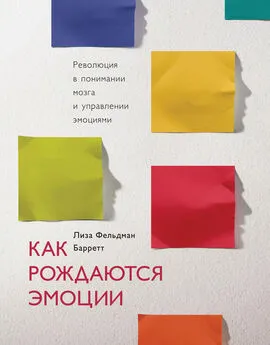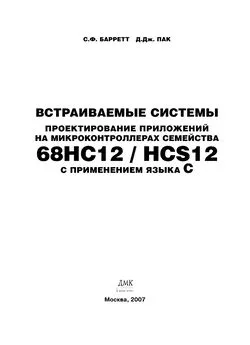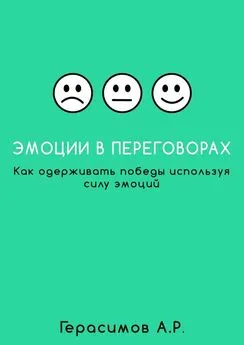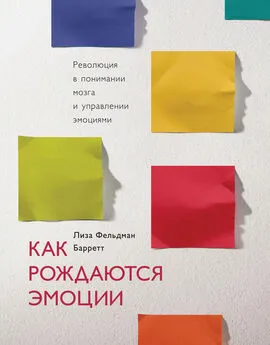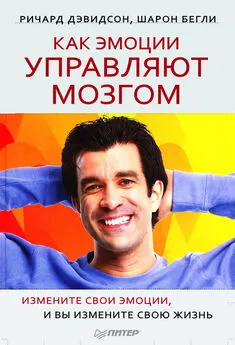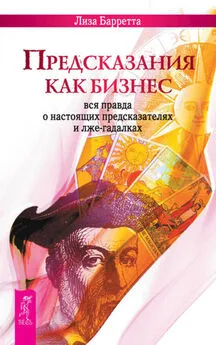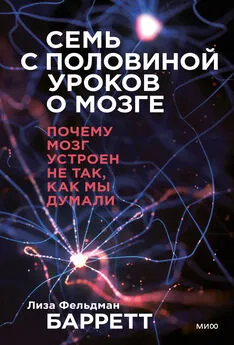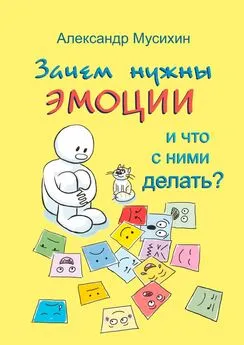Лиза Барретт - Как рождаются эмоции
- Название:Как рождаются эмоции
- Автор:
- Жанр:
- Издательство:Манн, Иванов и Фербер
- Год:2018
- Город:Москва
- ISBN:нет данных
- Рейтинг:
- Избранное:Добавить в избранное
-
Отзывы:
-
Ваша оценка:
Лиза Барретт - Как рождаются эмоции краткое содержание
Эта книга совершает революцию в понимании эмоций, разума и мозга. Вас ждет захватывающее путешествие по удивительным маршрутам, с помощью которых мозг создает вашу эмоциональную жизнь. Вы научитесь по-новому смотреть на эмоции, свои взаимоотношения с людьми и в конечном счете на самих себя. На русском языке публикуется впервые.
Как рождаются эмоции - читать онлайн бесплатно ознакомительный отрывок
Интервал:
Закладка:
Holtzheimer, Paul E., Mary E. Kelley, Robert E. Gross, Megan M. Filkowski, Steven J. Garlow, Andrea Barrocas, Dylan Wint, Margaret C. Craighead, Julie Kozarsky, and Ronald Chismar. 2012. “Subcallosal Cingulate Deep Brain Stimulation for Treatment-Resistant Unipolar and Bipolar Depression.” Archives of General Psychiatry 69 (2): 150–158.
Horowitz, Alexandra. 2009. “Disambiguating the ‘Guilty Look’: Salient Prompts to a Familiar Dog Behaviour.” Behavioural Processes 81 (3): 447–452.
Hoyt, Michael A., Annette L. Stanton, Julienne E. Bower, KaMala S. Thomas, Mark S. Litwin, Elizabeth C. Breen, and Michael R. Irwin. 2013. “Inflammatory Biomarkers and Emotional Approach Coping in Men with Prostate Cancer.” Brain, Behavior, and Immunity 32: 173–179.
Hunter, Richard G., and Bruce S. McEwen. 2013. “Stress and Anxiety Across the Lifespan: Structural Plasticity and Epigenetic Regulation.” Epigenomics 5 (2): 177–194.
Huntsinger, Jeffrey R., Linda M. Isbell, and Gerald L. Clore. 2014. “The Affective Control of Thought: Malleable, Not Fixed.” Psychological Review 121 (4): 600–618.
Innocence Project. 2015. “Eyewitness Misidentification.” http://www.innocenceproject.org/causes-wrongful-conviction/eyewitness-misidentification.
International Association for the Study of Pain. 2012. “IASP Taxonomy.” http://www.iasp-pain.org/Taxonomy.
Inzlicht, Michael, Bruce D. Bartholow, and Jacob B. Hirsh. 2015. “Emotional Foundations of Cognitive Control.” Trends in Cognitive Sciences 19 (3): 126–132.
Irwin, Michael R., and Steven W. Cole. 2011. “Reciprocal Regulation of the Neural and Innate Immune Systems.” Nature Reviews Immunology 11 (9): 625–632.
Iwata, Jiro, and Joseph E. LeDoux. 1988. “Dissociation of Associative and Nonassociative Concomitants of Classical Fear Conditioning in the Freely Behaving Rat.” Behavioral Neuroscience 102 (1): 66–76.
Izard, Carroll E. 1971. The Face of Emotion. East Norwalk, CT: Appleton-Century-Crofts.
——— . 1994. “Innate and Universal Facial Expressions: Evidence from Developmental and Cross-Cultural Research.” Psychological Bulletin 115 (2): 288–299.
Jablonka, Eva, Marion J. Lamb, and Anna Zeligowski. 2014. Evolution in Four Dimensions: Genetic, Epigenetic, Behavioral, and Symbolic Variation in the History of Life . Revised edition. Cambridge, MA: MIT Press.
James, William. 1884. “What Is an Emotion?” Mind 34: 188–205.
——— . (1890) 2007. The Principles of Psychology . Vol. 1. New York: Dover.
——— . 1894. “The Physical Basis of Emotion.” Psychological Review 1: 516–529.
Jamieson, J. P., M. K. Nock, and W. B. Mendes. 2012. “Mind over Matter: Reappraising Arousal Improves Cardiovascular and Cognitive Responses to Stress.” Journal of Experimental Psychology : General 141 (3): 417–422.
Jamieson, Jeremy P., Aaron Altose, Brett J. Peters, and Emily Greenwood. 2016. “Reappraising Stress Arousal Improves Performance and Reduces Evaluation Anxiety in Classroom Exam Situations.” Social Psychological and Personality Science 7 (6): 579–587.
Jamieson, Jeremy P., Wendy Berry Mendes, Erin Blackstock, and Toni Schmader. 2010. “Turning the Knots in Your Stomach into Bows: Reappraising Arousal Improves Performance on the GRE.” Journal of Experimental Social Psychology 46 (1): 208–212.
Jamieson, Jeremy P., Wendy Berry Mendes, and Matthew K. Nock. 2013. “Improving Acute Stress Responses: The Power of Reappraisal.” Current Directions in Psychological Science 22 (1): 51–56.
Jamieson, Jeremy P., Matthew K. Nock, and Wendy Berry Mendes. 2013. “Changing the Conceptualization of Stress in Social Anxiety Disorder Affective and Physiological Consequences.” Clinical Psychological Science 1: 363–374.
Jamison, Kay R. 2005. Exuberance: The Passion for Life . New York: Vintage Books.
Jeste, Shafali S., and Daniel H. Geschwind. 2014. “Disentangling the Heterogeneity of Autism Spectrum Disorder Through Genetic Findings.” Nature Reviews Neurology 10 (2): 74–81.
Ji, Ru-Rong, Temugin Berta, and Maiken Nedergaard. 2013. “Glia and Pain: Is Chronic Pain a Gliopathy?” Pain 154: S10–S28.
Job, Veronika, Gregory M. Walton, Katharina Bernecker, and Carol S. Dweck. 2013. “Beliefs About Willpower Determine the Impact of Glucose on Self-Control.” Proceedings of the National Academy of Sciences 110 (37): 14837–14842.
——— . 2015. “Implicit Theories About Willpower Predict Self-Regulation and Grades in Everyday Life.” Journal of Personality and Social Psychology 108 (4): 637–647.
Johansen, Joshua P., and Howard L. Fields. 2004. “Glutamatergic Activation of Anterior Cingulate Cortex Produces an Aversive Teaching Signal.” Nature Neuroscience 7 (4): 398–403.
John-Henderson, Neha A., Michelle L. Rheinschmidt, and Rodolfo Mendoza-Denton. 2015. “Cytokine Responses and Math Performance: The Role of Stereotype Threat and Anxiety Reappraisals.” Journal of Experimental Social Psychology 56: 203–206.
John-Henderson, Neha A., Jennifer E. Stellar, Rodolfo Mendoza-Denton, and Darlene D. Francis. 2015. “Socioeconomic Status and Social Support: Social Support Reduces Inflammatory Reactivity for Individuals Whose Early-Life Socioeconomic Status Was Low.” Psychological Science 26 (10): 1620–1629.
Jones, Colin. 2014. The Smile Revolution in Eighteenth Century Paris . New York: Oxford University Press.
Josefsson, Torbjörn, Magnus Lindwall, and Trevor Archer. 2014. “Physical Exercise Intervention in Depressive Disorders: Meta-Analysis and Systematic Review.” Scandinavian Journal of Medicine and Science in Sports 24 (2): 259–272.
Jussim, L., J. T. Crawford, S. M. Anglin, J. Chambers, S. T. Stevens, and F. Cohen. 2009. “Stereotype Accuracy: One of the Largest Relationships in All of Social Psychology.” In Handbook of Prejudice, Stereotyping, and Discrimination , 2nd edition, edited by Todd D. Nelson, 31–64. New York: Psychology Press.
Jussim, Lee. 2012. Social Perception and Social Reality: Why Accuracy Dominates Bias and Self-Fulfilling Prophecy . New York: Oxford University Press.
Jussim, Lee, Thomas R. Cain, Jarret T. Crawford, Kent Harber, and Florette Cohen. 2009. “The Unbearable Accuracy of Stereotypes.” Handbook of Prejudice, Stereotyping, and Discrimination , 2nd edition, edited by Todd D. Nelson, 199–227. New York: Psychology Press.
Kagan, Jerome. 2007. What Is Emotion?: History, Measures, and Meanings . New Haven, CT: Yale University Press.
Kahan, Dan M., David A. Hoffman, Donald Braman, and Danieli Evans. 2012. “They Saw a Protest: Cognitive Illiberalism and the Speech-Conduct Distinction.” Stanford Law Review 64: 851.
Kahan, Dan M., and Martha C. Nussbaum. 1996. “Two Conceptions of Emotion in Criminal Law.” Columbia Law Review 96 (2): 269–374.
Kahneman, Daniel. 2011. Thinking, Fast and Slow . New York: Macmillan.
Kaiser, Roselinde H., Jessica R. Andrews-Hanna, Tor D. Wager, and Diego A. Pizzagalli. 2015. “Large-Scale Network Dysfunction in Major Depressive Disorder: A Meta-Analysis of Resting-State Functional Connectivity.” JAMA Psychiatry 72 (6): 603–611.
Kaminski, Juliane, Juliane Bräuer, Josep Call, and Michael Tomasello. 2009. “Domestic Dogs Are Sensitive to a Human’s Perspective.” Behaviour 146 (7): 979–998.
Karlsson, Håkan, Björn Ahlborg, Christina Dalman, and Tomas Hemmingsson. 2010. “Association Between Erythrocyte Sedimentation Rate and IQ in Swedish Males Aged 18–20.” Brain, Behavior, and Immunity 24 (6): 868–873.
Karmiloff-Smith, Annette. 2009. “Nativism Versus Neuroconstructivism: Rethinking the Study of Developmental Disorders.” Developmental Psychology 45 (1): 56–63.
Kashdan, Todd B., Lisa Feldman Barrett, and Patrick E. McKnight. 2015. “Unpacking Emotion Differentiation Transforming Unpleasant Experience by Perceiving Distinctions in Negativity.” Current Directions in Psychological Science 24 (1): 10–16.
Kashdan, Todd B., and Antonina S. Farmer. 2014. “Differentiating Emotions Across Contexts: Comparing Adults With and Without Social Anxiety Disorder Using Random, Social Interaction, and Daily Experience Sampling.” Emotion 14 (3): 629–638.
Kashdan, Todd B., Patty Ferssizidis, R. Lorraine Collins, and Mark Muraven. 2010. “Emotion Differentiation as Resilience Against Excessive Alcohol Use an Ecological Momentary Assessment in Underage Social Drinkers.” Psychological Science 21 (9): 1341–1347.
Kassam, Karim S., and Wendy Berry Mendes. 2013. “The Effects of Measuring Emotion: Physiological Reactions to Emotional Situations Depend on Whether Someone Is Asking.” PLOS One 8 (6): e64959. doi:10.1371/journal.pone.0064959.
Kassin, Saul M., V. Anne Tubb, Harmon M. Hosch, and Amina Memon. 2001. “On the ‘General Acceptance’ of Eyewitness Testimony Research: A New Survey of the Experts.” American Psychologist 56 (5): 405–416.
Katz, Lynn Fainsilber, Ashley C. Maliken, and Nicole M. Stettler. 2012. “Parental Meta-Emotion Philosophy: A Review of Research and Theoretical Framework.” Child Development Perspectives 6 (4): 417–422.
Keefe, P. R. 2015. “The Worst of the Worst.” New Yorker , September 14. http://www.newyorker.com/magazine/2015/09/14/the-worst-of-the-worst.
Keil, Frank C., and George E. Newman. 2010. “Darwin and Development: Why Ontogeny Does Not Recapitulate Phylogeny for Human Concepts.” In The Making of Human Concepts , edited by Denis Mareschal, Paul Quinn, and Stephen E. G. Lea, 317–334. New York: Oxford University Press.
Kelly, Megan M., John P. Forsyth, and Maria Karekla. 2006. “Sex Differences in Response to a Panicogenic Challenge Procedure: An Experimental Evaluation of Panic Vulnerability in a Non-Clinical Sample.” Behaviour Research and Therapy 44 (10): 1421–1430.
Keltner, Dacher, and Jonathan Haidt. 2003. “Approaching Awe, a Moral, Spiritual, and Aesthetic Emotion.” Cognition and Emotion 17 (2): 297–314.
Khandaker, Golam M., Rebecca M. Pearson, Stanley Zammit, Glyn Lewis, and Peter B. Jones. 2014. “Association of Serum Interleukin 6 and C-Reactive Protein in Childhood with Depression and Psychosis in Young Adult Life: A Population-Based Longitudinal Study.” JAMA Psychiatry 71 (10): 1121–1128.
Kiecolt-Glaser, Janice K. 2010. “Stress, Food, and Inflammation: Psychoneuroimmunology and Nutrition at the Cutting Edge.” Psychosomatic Medicine 72 (4): 365–369.
Kiecolt-Glaser, Janice K., Jeanette M. Bennett, Rebecca Andridge, Juan Peng, Charles L. Shapiro, William B. Malarkey, Charles F. Emery, Rachel Layman, Ewa E. Mrozek, and Ronald Glaser. 2014. “Yoga’s Impact on Inflammation, Mood, and Fatigue in Breast Cancer Survivors: A Randomized Controlled Trial.” Journal of Clinical Oncology 32 (10): 1040–1051.
Kiecolt-Glaser, Janice K., Lisa Christian, Heather Preston, Carrie R. Houts, William B. Malarkey, Charles F. Emery, and Ronald Glaser. 2010. “Stress, Inflammation, and Yoga Practice.” Psychosomatic Medicine 72 (2): 113–134.
Kiecolt-Glaser, Janice K., Jean-Philippe Gouin, Nan-ping Weng, William B. Malarkey, David Q. Beversdorf, and Ronald Glaser. 2011. “Childhood Adversity Heightens the Impact of Later-Life Caregiving Stress on Telomere Length and Inflammation.” Psychosomatic Medicine 73 (1): 16–22.
Читать дальшеИнтервал:
Закладка:
